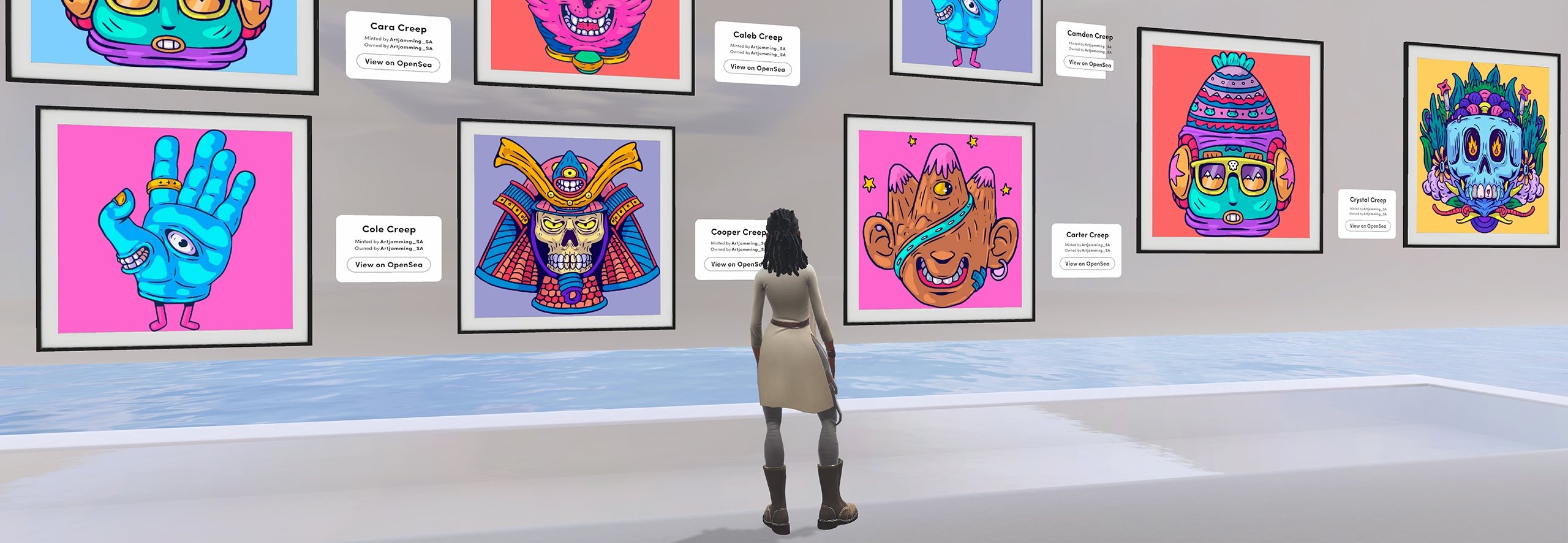Women in Tech global talent director outlines opportunities in a ‘diverse metaverse’ future
IN BRIEF
- We’re on a precipice, and I feel like there’s just so much potential change ahead… We view the metaverse as a golden opportunity for women to play a much bigger role in emerging tech.
- I don’t think it’s out of the realm of possibility that people will live in the metaverse. Or at least, spend the majority of their time in it, especially if they are earning money in the metaverse.
- I hope the metaverse doesn’t follow the same track technology did for most of the last 50 years—where one predominant group of individuals creates products and solutions that surely would’ve been better had they been developed by more diverse teams. I hope we’ve learned from our mistakes, and the metaverse future is different.
Melissa Slaymaker is Global Talent Hub Director for Women in Tech, a Paris-based not-for-profit organization with the mission of connecting women to technology and leadership roles, as well as the ambitious goal of empowering 5 million women and girls in STEM by 2030. The organization, with over 200,000 members in 45 countries on six continents, gives women—from students and entry-level employees to C-level executives—access to the technology, digital and engineering job opportunities available around the globe. Slaymaker, who is based in Cape Town, is also co-founder of NFTY-art.com, a startup that helps educate African artists on how to mint original art into NFTs that can be sold in the metaverse. Slaymaker, who has served as an advisory member on the African Board of Digital Commerce, sat down with Joe Kornik, Editor-in-Chief of VISION by Protiviti, to discuss women’s role in the metaverse future.
Kornik: When you look at the future of technology, specifically Web 3 and the metaverse, what excites you the most?
Slaymaker: What excites me the most about Web 3 and the metaverse is where it is all leading: An increased decentralization and democratization of the internet. What do I mean by that? The emergence of new technologies, especially blockchain, has the potential to really level the playing field. Blockchain was created, essentially, to secure a transparent digital marketplace, and this gives me great hope because that means blockchain has the potential of creating a new world in the metaverse, an inclusive word and an equitable world.. As the global talent hub director for Women in Tech, that’s obviously appealing to me because there are so many new opportunities being created every day because of Web 3 and the metaverse; it's a world everyone can help shape. We’re on a precipice, and I feel like there’s just so much potential change ahead. I think that’s what excites me the most—the unknown future. I’m thrilled that, in some small way, I’ll get to influence it.
Kornik: What opportunities do you see for women in the metaverse, which as you point out, is wide open and perhaps, ready for change?
Slaymaker: So, there's good news and bad news: The bad news is there’s still a gender gap within the technology sector, and to some extent, within the metaverse. The metaverse has some of the built-in-limitations the traditional technology sector has when it comes to women and diversity in general. But the good news is that’s all changing. At Women in Tech, we view Web 3 and the metaverse as a golden opportunity for women to play a much bigger role in emerging tech, perhaps even as leaders and entrepreneurs in a new digital economy. We believe in the idea of the “diverse metaverse.” Now, how do we get there? Well, we’re working with companies on their diversity and equality initiatives, hiring practices, maternity and paternity leave—all of these policies impact women’s ability to have a level playing field. That’s at the corporate level. And then we also look to empower younger women and girls, and other underrepresented groups within the tech sector. It starts with education. We often host career days at schools and universities. At high schools, we find so many girls have never considered technology as a career option. That needs to change. And at universities, even computer science majors aren’t all that well-versed in the metaverse, or Web 3 or NFTs or blockchain. That told me there was a problem, and we needed to educate young people to make sure they were ready for the future in technology. The metaverse, and specifically blockchain, is going to impact every single sector, from agriculture and healthcare to manufacturing and financial technology.
Kornik: I know one of the goals at Women in Tech Global is to empower 5 million women and girls in STEM by 2030. How do you achieve that?
Slaymaker: Yes! Really, it follows the United Nations’ lead as part of its sustainable development goals around gender equality. So, we took that to heart and came up with our own goal, but it won’t be easy. The challenges with women in technology have been around since the 1970s. But because the metaverse is such a new and exciting space to be in, the possibilities for women are limitless. I mentioned blockchain earlier and its advantages—no one owns it, it is decentralized, and it’s a virtual space that will create more opportunities for everyone, including job opportunities for developers and coders, as it expands. I know some fantastic female coders; I just don’t know enough of them. The metaverse is creating new companies and new opportunities, literally every day. I see it in my role as global talent hub director. We work with companies to place women in these jobs, and certainly the leaders we work with understand the need for diversity, see the real benefit of having women coders and developers, as well as recognize the value in having women in technology leadership roles. So, we are seeing steps in the right direction, for sure, we just need more of them. We’re making progress, but 2030 is only seven years away. We have a lot of work to do.
At Women in Tech, we view Web 3 and the metaverse as a golden opportunity for women to play a much bigger role in emerging tech, perhaps even as leaders and entrepreneurs in a new digital economy.
Kornik: For most people, gaming is their first entry into the metaverse. Isn’t that still typically a male-dominated space? How do we get more women and girls into the metaverse?
Slaymaker: I think that was probably true a few years ago, but it’s leveling out. I have a 17-year-old daughter and she games in the metaverse. And so do her friends. I just think we need to shift our mindset of what a gamer in the metaverse looks like. It’s changing, and the more time women and girls spend in immersive worlds, the more likely they’ll be to think about technology as a career, and less likely they’ll miss out on a big opportunity.
Kornik: You are also co-founder of NFTY-art and you’ve said one of your goals is to “demystify the metaverse through the promotion and adoption of blockchain technology.” Talk to me about how you are helping African artists showcase their art in the metaverse?
Slaymaker: I don't know how much time you’ve spent in the metaverse or in Minecraft or Roblox, but an avatar can create things in the metaverse. So, for creative people, the metaverse is a fantastic opportunity. An artist can create an authentic piece of art in the metaverse—it could be 3D art, a painting, a song—that can be minted as an NFT, non-fungible token, and sold for real cryptocurrency. So again, it's about educating about new opportunities and as you mentioned, “demystifying the metaverse,” especially for young people. So, I teamed up with a partner who owns an art studio in Cape Town, and we developed a curriculum for artists who want to create in the metaverse. We have our own African art collective in the metaverse where people—or avatars!—anywhere in the world can browse and purchase NFTs from African artists. It’s been a big success and a lot of fun so far.
Kornik: When you look out a decade or more, what do you see for the metaverse?
Slaymaker: Well, I am an optimist, and I think a decade from now the metaverse will be something nearly everyone is tapped into. I think VR headsets will be in every household. I think it will be the way business is done, the way students are educated, and maybe this will sound too futuristic, but the way some people will live in the future. I don’t think it’s out of the realm of possibility that some people will actually live in the metaverse. Or at least spend the majority of their time in it, especially if they are making money in the metaverse.
Kornik: Wow. I wasn’t expecting that…
Slaymaker: I know, but you asked! Personally, I like being in the real world so that’s probably not my future, but I do think that will be an option available for people who prefer to live in the metaverse. And finally, my hope is that a decade from we will have a diverse metaverse represented by all sorts of people, not just women. I envision a fair and equitable metaverse. And I hope the metaverse doesn’t follow the same track technology did for most of the last 50 years—where one predominant group of individuals create products and solutions that surely would’ve been better had they been developed by more diverse teams. I hope we’ve learned from our mistakes, and the metaverse future will be different. I’m optimistic it will be.
An artist can create an authentic piece of art in the metaverse — it could be 3D art, a painting, a song — that can be minted as an NFT, non-fungible token, and sold for real cryptocurrency.





































